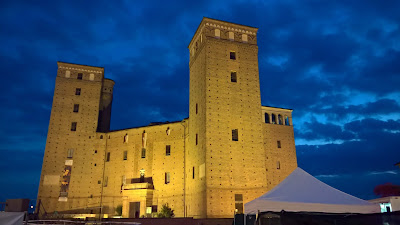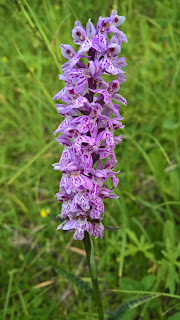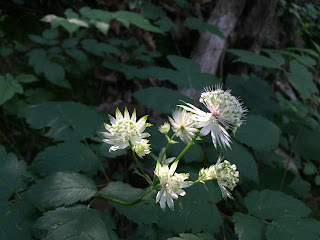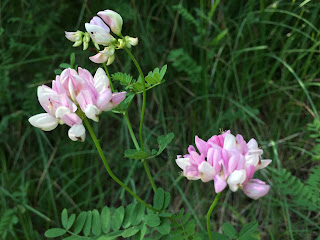English: I talk, you talk, he talks, we talk, you talk, they talk
Italian: io parlo, tu parli, lui parla, noi parliamo, voi parlate, loro parlano
In English, the pronunciation doesn’t change over the different forms: talk is pronounced the same. However, in Italian, spelling and pronunciation is different. With stress marks added for clarity, we have:
Italian: io pàrlo, tu pàrli, lui pàrla, noi parliàmo, voi parlàte, loro pàrlano
The example above is a relatively easy verb to conjugate and pronounce. There are other verbs that are not so easy, ones on which I always choke on getting out the correct pronunciation.
When I thought about it, I realized my problem with pronunciation of certain verbs was due to understanding where the tonic accent fell, that is, the stressed syllable changed in a way that I wasn’t expecting, or at least, I wasn’t used to. And, it turns out that the problem is related to conjugated verb forms where the third-from-last syllable is stressed. (For more on the general subject, see Italian Words with Tonic Stress on Third-From-Last Syllable.)
In thinking about the types of verbs that have the third-from-last syllable stressed in conjugated forms, I stumbled across five interesting points about Italian verbs that I include here.
Point #1: You only need to look at the first-person singular form of an Italian verb to understand the pronunciation pattern for that verb in the simple present indicative. The first-person pronunciation, or really where to put the stress, applies to the singular forms and the third-person plural form. The first-person and second-person plural forms have a more predictable pronunciation. You can see this in the example above for the verb parlare. pàrlo, pàrli, pàrla, and pàrlano share the same stress while parliàmo and parlàte have the stress in the ending or suffix (in bold).
Some dictionaries indicate the stress for the conjugations like la Repubblica.it dictionary. For example, see the entry for parlare. Other dictionaries, like the popular WordReference.com, don’t give any indication of stress. For example, for parlare notice that there is no indication on where to put the stress.
The first-person singular form’s pronunciation for simple present indicative also applies to present subjunctive present (pàrli) and imperative conjugations (pàrla). However, in all other indicative tenses, the endings are stressed: imperfetto (parlàvo), passato remote (parlài), and futuro (parlerò). As well, endings are stressed for congiuntivo imperfetto (parlàssi) and condizionale (parlerèi).
Point #2: Before I started this post, I assumed the infinitive form of all verbs had their stressed accent on the endings ARE, ERE, and IRE. However, that isn’t correct.
- The infinitive form of verbs ending in ARE are always accented second-from-last, that is, in the ARE ending. Examples are: accomodàre, lavoràre, meritàre, parlàre, and trasportàre.
- The infinitive form of verbs ending ERE are of two types: those where the stress falls on the verb root (specifically, the last vowel of the root) and those where the stress falls on the ERE ending. Examples of the first type are: conóscere, méttere, and ripètere. Examples of the second type are: cadére, piacére, and vedére.
- The infinitive form of verbs ending in IRE are always accented on the ending like ARE verbs. Examples are: aprìre, capìre, finìre, and servìre.
I arrived at the summary above based on my personal experience and lots of dictionary look-ups. Later, I found confirmation in the article Stress on Second Conjugation Infinitives in Italian published in the journal Italic, Vol. 64, No. 3, Linguistics: Theoretical and Applied (Autumn, 1987), pp. 477-498. In the article, the authors are concerned with how the stress is assigned to second conjugation infinitives (ERE) and what might be ways to teach students of Italian to recognize the two types (stress on root or stress on ending).
Point #3: I had been wondering for some time about pronouncing Italian verbs correctly and one day I stumbled on the Dummies Italian Grammar for Dummies Cheat Sheet, and there I found the magic words I had been searching for: “Certain Italian verbs, usually those with Latin roots, are accented differently from the norm. Instead of the stress falling on the usual next-to-last syllable, the stress falls on the third-to-last syllable…”
After a little more digging, I found the Centro Studi Italiani page on Retrocessione dell’accento where it is explained that the stressed syllable in the conjugation of verb can be tricky, in particular, for some ARE verbs where the accent of the conjugated forms is on the third-from-last syllable. They also provide a list of such tricky verbs from which many of the examples of ARE verbs in the list below are drawn.
I breathed a sigh of relief realizing I wasn’t exactly crazy and there was something simple I could do: I could just look the verb up in a proper dictionary to work out the pronunciation. I was, however, also a little bit frustrated because I was again face-to-face with my “sdrucciola problem”. (For more on that subject, see Italian Words with Tonic Stress on Third-From-Last Syllable.)
The change in accent can be seen with these ARE verbs where accent marks are added for the purpose of discussion:
Infinitive
|
First-person conjugation
|
| accomodàre | io accòmodo |
| meritàre | io mèrito |
| terminàre | io tèrmino |
| vincolàre | io vìncolo |
Notice how the accent jumps from the second-from-last syllable in the infinitive form to the third-from-last syllable in the conjugated form. In other words, the conjugated forms are not io accomòdo, io merìto, io termìno,and io vincòlo as you might guess. In fact, saying this way will cause Italians to cringe. Believe me, I've done it enough.
And while there is no hard and fast rule (at least that I could find) for telling which ARE verbs are subject to this jump (or retrocessione) of accent, it does bring us to an interesting suggestion I found in a WordReference.com forum post. In that post, one of the responses suggests that for Italian verbs ending in ARE, the third-from-last cases mostly involve verbs that derive from other words (nouns, adjectives) and that the verbs tend to keep the stressed syllable of the original word. Starting with the same examples in the preceding table where the accent jumps and adding other examples where the accent doesn't jump, we have:
| Noun | Infinitive | First-person Conjugation | Sdrucciola |
| l’accòmodo | accomodàre | io accòmodo | yes |
| il mèrito | meritàre | io mèrito | yes |
| il tèrmine | terminàre | io tèrmino | yes |
| il vìncolo | vincolàre | io vìncolo | yes |
| il bàcio | baciàre | io bàcio | no |
| il cancéllo | cancellàre | io cancèllo | no |
| il lavóro | lavoràre | io lavóro | no |
Therefore, I propose that if you know the associated noun of an ARE verb, start there with your pronunciation of the conjugated forms (but not for first and second-person plural as noted above in Point #1). This rule of thumb works whether the accent jumps to the third-from-last syllable or not.
Point #4: We are taught from week one in our Italian classes that there are three classes of verbs, those ending in ARE, ERE, and IRE. As I was researching this post, I realized that I wasn’t sure where Italian verbs ending in ARRE, ORRE, and URRE fit in. I found that they are usually lumped in with ERE verbs because they derive from older Latin verbs ending in ERE: condurre from conducere, porre from ponere, and trarre from trahĕre. The ĕ represents a short-conjugated vowel as in the e in decidere.
Point #5: The stress on the infinitive form of a verb is not affected by the addition of prefixes used to create a new verb or suffixes denoting objects (direct or indirect) or particles. For example:
| Infinitive Form | Related Infinitive Form |
| andàre | andàrsene |
| chièdere | chièdergliela |
| entràre | rientràre |
| fàre | fàrecela |
| lèggere | rilèggere |
| telefonàre | telefonàrgli |
| vestìre | svestìre |
In the following lists, the infinitive form is show along with the first-person singular in parenthesis for the present simple indicative. As discussed above in Point #1, the first-person singular conjugate form tells you about the second and third-person singular and the third-person plural pronunciation. The first and second-person plural pronunciation always has a different stressed syllable.
Finally, repeating what was mentioned above: the stress marks are shown here for the purpose of discussion. They are not normally used when writing unless they are needed to clarify between homographs as discussed in the post People and Place Names in Italian: Correct Pronunciation.
I. Verbs that end in ARE
I.A The tonic stress is on the third-from-last syllable in conjugated forms
abitàre (àbito), auguràre (àuguro), brontolàre (bróntolo), capitàre (càpito), celebràre (cèlebro), comunicàre (comùnico), coniugàre (còniugo), consideràre (consìdero), consigliàre (consìglio), dimenticàre (diméntico), dominàre (dòmino), elemosinàre (elemòsino), esageràre (esàgero), escogitàre (escògito), formulàre (fòrmulo), identificàre (identìfico), indicàre (ìndico), immaginàre (immàgino), liberàre (lìbero), meritàre (mèrito), morisicàre (mòrsico), occupàre (òccupo), ordinàre (órdino), operàre (òpero), partecipàre (partècipo), pianificàre (pianìfico), provocàre (pròvoco), pullulàre (pùllulo), scodinzolàre (scodìnzolo), significàre (signìfico), superàre (sùpero), telefonàre (telèfono), terminàre (tèrmino), ubicàre (ùbico), unificàre (unìfico), vagolàre (vàgolo), verificàre (verìfico), vincolàre (vìncolo), visitàre (vìsito), zuccheràre (zùcchero)
I.B The tonic stress is on second-from-last syllable in conjugated forms
alzàre (àlzo), arrivàre (arrìvo), aspettàre (aspètto), assaporàre (assapóro), baciàre (bàcio), bruciàre (brùcio), camminàre (cammìno), cancellàre (cancèllo), cantàre (canto), cercàre (cérco), chiamàre (chiàmo), circondàre (circóndo), combinàre (combìno), compàre (cómpro), consegnàre (conségno), controllàre (contròllo), crollàre (cròllo), cucinàre (cucìno), entràre (éntro), fasciàre (fàscio), fermàre (férmo), frequentàre (frequènto), imparàre (impàro), lavàre (làvo), lavoràre (lavóro), mangiàre (màngio), organizzàre (organìzzo), paragonàre (paragóno), parlàre (pàrlo), passàre (pàsso), pensàre (pènso), portàre (pòrto), odiàre (òdio), pagàre (pàgo), segàre (ségo), spiegàre (spiègo), studiàre (stùdio), svegliàre (svéglio), trasportàre (traspòrto), tornàre (tórno), trovàre (tròvo), volàre (vólo)
I.C Irregulars
andàre (vàdo), dàre (do), fàre (fàccio), stàre (sto)
II. Verbs that end in ERE
II.A Stress on the last vowel in the root of the verb
accèndere (accèndo), chièdere (chièdo), conóscere (conósco), corrèggere (corrèggo), córrere (córro), decìdere (decìdo), distìnguere (distìnguo), divìdere (divìdo), èssere (sóno), esplòdere (esplòdo), fóndere (fóndo), giùngere (giùngo), lèggere (lèggo), méttere (métto), nàscere (nàsco), occórrere (occórro), pèrdere (pèrdo), prèndere (prèndo), règgere (règgo), resìstere (resìsto), ripètere (ripèto), scégliere (scélgo), sciògliere (sciòlgo), scrìvere (scrìvo), spègnere (spègno), vìncere (vìnco), vìvere (vìvo)
II.B Stress on the ending ERE
avére (ho), bére (bévo), cadére (càdo), dovére (dèvo), godére (gòdo), piacére (piàccio), parére (pàio), potére (pòsso), sapére (so), temére (témo), tenére (tèngo), valére (vàlgo), vedére (védo), volére (vòglio)
II.C Verbs that end in ARRE, ORRE, or URRE are often grouped under ERE verbs
condùrre (condùco), pórre (póngo), tràrre (tràggo)
There are a greater number of verbs in group II.A as compared to group II.B.
III. Verbs that end in IRE
acquisìre (acquisìsco), aprìre (àpro), attribuìre (attribuìsco), capìre (capìsco), costruìre (costruìsco), dìre (dìco), divertìre (divèrto), dormìre (dòrmo), finìre (finìsco), offrìre (òffro), percepìre (percepìsco), proibìre (proibìsco), pulìre (pulìsco), restituìre (restituìsco), seguìre (sèguo), sentìre (sènto), servìre (sèrvo), spedìre (spedisco), soffrìre (sòffro), trasferìre (trasferìsco), ubbidìre (ubbidìsco), udìre (òdo), vestìre (vèsto)

















































